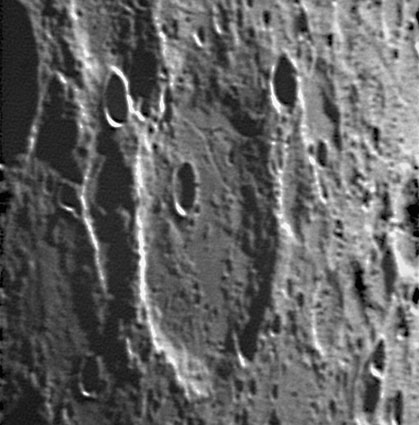Difference between revisions of "June 29, 2004"
| Line 27: | Line 27: | ||
<p class="story" align="left"><b>Related Links: </b><br> | <p class="story" align="left"><b>Related Links: </b><br> | ||
[http://observingthesky.org/index.php?p=188 Jim Phillips & Scope] <br> | [http://observingthesky.org/index.php?p=188 Jim Phillips & Scope] <br> | ||
| − | [ | + | [http://www.lpi.usra.edu/research/lunar_orbiter/images/img/iv_184_h2.jpg Lunar Orbiter IV View ]</p> |
<p><b>Yesterday's LPOD:</b> [[June 28, 2004|LACs and More!]] </p> | <p><b>Yesterday's LPOD:</b> [[June 28, 2004|LACs and More!]] </p> | ||
<p><b>Tomorrow's LPOD:</b> [[June 30, 2004|Tobacco Lunar Science]] </p> | <p><b>Tomorrow's LPOD:</b> [[June 30, 2004|Tobacco Lunar Science]] </p> | ||
Latest revision as of 22:39, 8 February 2015
Fantastic Furnerius
Image Credit: Jim Phillips |
|
Fantastic Furnerius "Fantastic" is probably not an adjective that would have been applied to Furnerius anytime during the last 3 billion years! It is a much modified older crater that has seen better eons. But this is a fantastic telescopic image - better than any in the Consolidated Lunar Atlas or any other I've seen. So what does it tell us? Well, Furnerius is big enough (diameter 125 km) so that when it was formed it certainly was deep, had central peaks, and wall terraces - in fact, it probably looked like Langrenus (dia. 132 km). Today Furnerius is bedraggled - it is shallow, lacks terraces and the floor is drizzled with later impacts and hills, one of which could be a central peak. Parts of the floor are smooth and a full Moon look shows that this material is dark. It is thus mare lava, perhaps an outlier of the Mare Australe, characterized by mare lavas that pool on crater floors. Jim's image captures very nicely the poorly known rille that cuts thru both rough floor material as well as a piece of the mare material. The rough hills on the floor are probably ejecta from the formation of the Nectaris Basin, perhaps 3.92 billion years ago. And interestingly, the younger rille is roughly radial to Nectaris. Technical Details: Related Links: Yesterday's LPOD: LACs and More! Tomorrow's LPOD: Tobacco Lunar Science |
Author & Editor: |
COMMENTS?
Register, Log in, and join in the comments.




